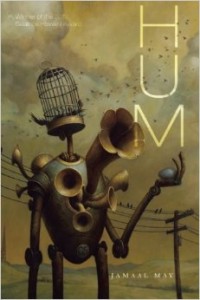Hum by Jamaal May
 Hum
Hum
by Jamaal May
Alice James Books, Nov 2013
80 pages / $15.95 Buy from Amazon or SPD
Robert Frost’s “Out, Out—” depicts perhaps the most famous dismemberment in American poetry: a young boy loses his hand while working with a buzz saw, bleeds to death, and at the end of the poem, his parents indifferently “return to their affairs.” The poem induces a naturalistic sense of spiritual doubt, and it’s also suggestive of a wartime paranoia about technology’s potential for violence and destruction. Jamaal May’s debut collection Hum (Alice James, 2013) is driven by a relentless confrontation of the lines between natural and artificial, and it reinvents all of our typical assumptions about the relationship between technology and humanity. In a sly invocation of Frost, “Hum of the Machine God” depicts a father who loses his thumb while operating a snow blower. But unlike Frost, May doesn’t evoke the expected sense of lost innocence: the boy is not the victim of the tragedy, but rather, the witness. The machine isn’t a harbinger of modernist alienation, but rather, a spiritual entity in itself:
Gripped his shovel. Gripped his oar. Now, in a waiting
room, he bows to the florescent hum and begs. Ignore
my prayer, goes his stupid little prayer, please ignore
my voice. The thumb in a jar packed with snow,
will take a miracle for the doctors to reattach.
The poem sets the tone for the collection: there’s a sense of deep uneasiness about being alive, a constant teetering on the edge of violence and danger. If it seems risky to confront Frost, it’s worth noting that this is not only the second poem in the book, but also a sestina—a usually clunky form into which May breathes life (despite the fact that most of us can probably count the number of interesting sestinas we’ve read on one intact hand).
Numerous poems in Hum are concerned with machines: we see factories, broken-down automobiles, grenades, dead frogs stored in freezers, fallen industries—the book itself is dedicated in part to “the interior lives of Detroiters.” But in Hum, machinery isn’t a predictable representation of modern despair. Instead, it embodies a spiritual force, presenting a potential for energy, for both violence and renewal. May creates a world where the brand name of a G.E. freezer can stand for “God Engine,” and an appliance can stave off death and decay while “fly-dotted pears rot,/corpse-soft on the table.” Through a kind of inverted Romanticism, the poems waver toward the possibility of injury, often evoking a discomfort with the bodily and organic. Artifice is appealing precisely because of its ability to resist decay. We see this in the particularly memorable poem, “If They Hand Your Remains to Your Sister in a Chinese Takeout Box,” when the speaker encourages the reader to “Take solace that the plastic bag/carrying you to the cemetery will…/spend decades holding hands with a breeze.” Whereas the artificial, manmade world is (seemingly) able to transcend time and death, the human body is flawed. From “I Do Have a Seam”:
careful seamstress, you
needle in my sternum—
stitch my selvage as it frays,
you know how ragged I’ve been
December 20th, 2013 / 12:00 pm
